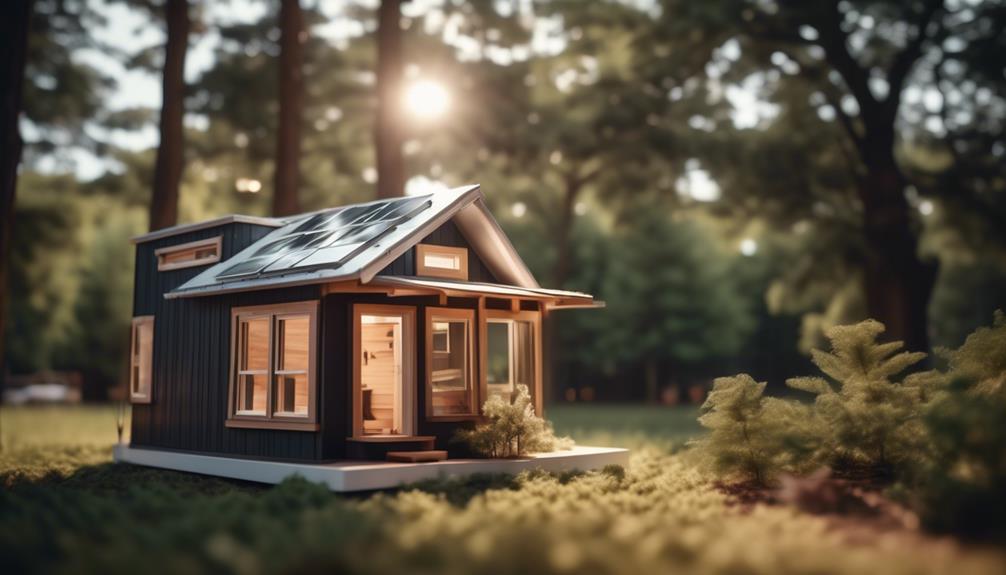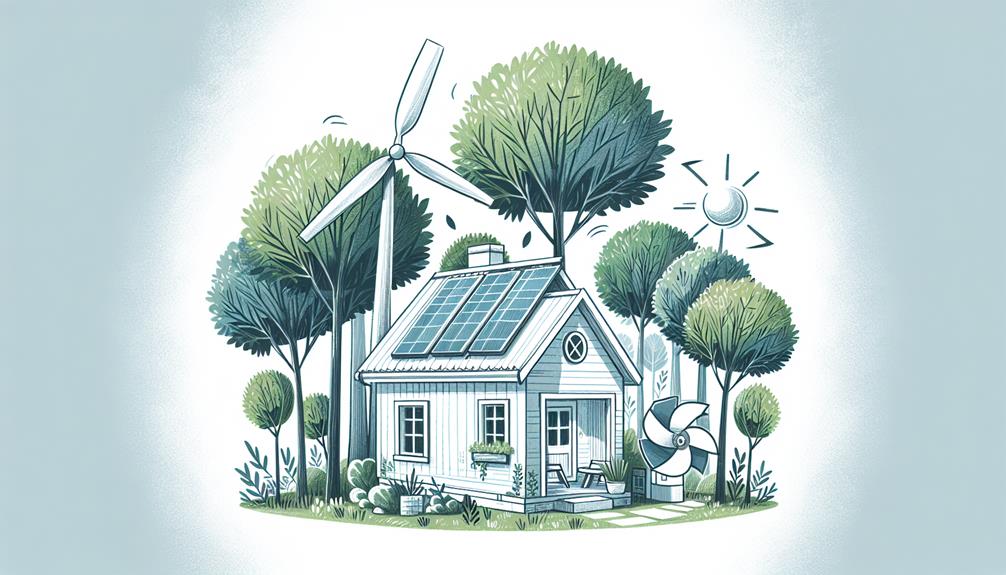You might think that keeping your tiny home cool during the blistering summer months is a near-impossible task, but with the right strategies, it's more manageable than you'd expect.
As you seek comfort from the sweltering heat, remember that the size of your space can be an advantage, allowing for efficient cooling solutions that won't break the bank. From maximizing insulation efficiency to upgrading to energy-efficient windows, each step you take can have a significant impact on your indoor climate.
Strategic ventilation and the use of reflective materials can further enhance your home's ability to stay cool. Yet, there are even more innovative methods and techniques that can transform your tiny abode into a cool oasis.
Curious about how shade, greenery, and certain design adjustments can play a pivotal role in maintaining a refreshing environment? Stay tuned, as we explore the secrets to creating a comfortable cool haven within your compact living space.
Key Takeaways
- Proper insulation is crucial for reducing heat exchange and keeping a tiny home cool. Insulate walls, windows, and doors effectively to mitigate heat transfer.
- Energy-efficient windows with low-E coatings and multi-paned glass help block UV rays and minimize heat gain. They also offer long-term investment value and lower energy costs.
- Utilize ventilation strategies such as positioning oscillating fans near openings, opening windows or vents on opposite sides for cross-ventilation, and using window units or ceiling fans to enhance airflow.
- Consider reflective roofing to reduce attic heat buildup, lower surface temperature, and decrease reliance on air conditioning. This can prolong the roof's lifespan and support passive cooling strategies. Additionally, integrating shade and greenery, such as shade trees and outdoor structures, can block direct sunlight and create a cooler environment. Solar shades, cooling curtains, vertical gardens, and green roofs also contribute to energy efficiency.
Maximize Insulation Efficiency
To keep your tiny home comfortably cool, ensure that you install proper insulation during the construction phase to block unwanted heat transfer and enhance energy efficiency. Insulated walls reduce heat exchange, preventing the outside heat from entering and maintaining a stable interior climate. Prioritize high-quality insulation for its ability to block the heat effectively, which contributes to significant energy savings over time.
Carefully selecting the type and thickness of insulation is crucial for maximizing cooling efficiency. Moreover, insulating windows and doors is imperative to mitigate heat transfer and complement passive cooling strategies. Although the initial cost may be higher, the long-term benefits justify the investment.
Remember to shut your shades to fortify your home's defense against the heat.
Upgrade to Energy-Efficient Windows
Upgrading to energy-efficient windows is a smart step in enhancing your tiny home's ability to remain cool and comfortable. These windows are designed to tackle the challenge of heat gain, ensuring your living space stays refreshing without overburdening your air conditioning system. Here's how you can leverage their benefits:
- Low-E Coatings:
- *Block UV rays*
- *Minimize heat gain*
- *Preserve interior furnishings*
- Multi-Paned Glass:
- *Double or triple layers*
- *Improved insulation*
- *Reduced air leakage*
- Installation Benefits:
- *Lower energy costs*
- *Enhanced natural cooling effect*
- *Long-term investment value*
Enhance Airflow With Strategic Ventilation

While energy-efficient windows play a crucial role in reducing heat gain, enhancing airflow with strategic ventilation is equally important for maintaining a comfortable climate in your tiny home.
Position oscillating fans near openings to draw in a natural breeze to cool your space. By opening windows or vents on opposite sides, you'll optimize cross-ventilation, allowing fresh air to circulate the air effectively.
Consider window units or ceiling fans to further enhance airflow. Setting a ceiling fan to rotate anticlockwise can push cool air downward, amplifying the refreshing effect.
Additionally, installing advanced ventilation systems offers precise control over the airflow, ensuring your tiny home remains a serene, cool haven.
Opt for Reflective Roofing Solutions
Reflective roofing materials, by deflecting sunlight, significantly reduce heat absorption and keep your tiny home cooler. These innovative solutions enhance your home's energy efficiency, directly impacting your cooling systems by minimizing the need for artificial cooling.
Here's how reflective roofing works:
- Reduces Temperature
- Diminishes attic heat buildup
- Lowers surface temperature of the roof
- Maintains a stable indoor temperature
- Energy Savings
- Decreases reliance on air conditioning systems
- Cuts down energy consumption and costs
- Sustainable Approach
- Prolongs roof lifespan by minimizing thermal shock
- Reduces carbon footprint of your home
- Supports passive cooling strategies
Opt for reflective roofing to ensure your tiny space remains comfortable while contributing to a greener, more sustainable living environment.
Integrate Shade and Greenery

Beyond investing in reflective roofing materials, integrating shade and greenery around your tiny home can further enhance its coolness and energy efficiency.
Planting shade trees strategically will help block direct sunlight, reducing heat transfer and keeping your home cool and comfortable.
Outdoor structures like pergolas or awnings also contribute to a natural flow of cool air, creating a cool and refreshing environment.
To further optimize cooling methods, consider installing solar shades or cooling curtains that prevent heat from infiltrating your living space.
Embrace passive cooling innovations such as vertical gardens or green roofs; these not only cool your home but improve air quality.
Frequently Asked Questions
How Can I Cool and Heat My Tiny House?
To cool and heat your tiny house, install mini split systems and roof insulation, employ cross ventilation, and hang thermal curtains. Use portable air conditioners, solar shades, evaporative coolers, window films, cooling fans, and ice boxes.
What Is the Best Heating Solution for a Tiny House?
You might think space constraints limit your heating options, but a mini split, radiant floor, or heat pump can efficiently warm your tiny house. Even a wood stove or pellet burner offers cozy, traditional heating.
Why Is There Less Heat Loss or Gain in a Tiny House?
You'll find your tiny house has less heat loss or gain due to its compact design, high insulation efficiency, favorable volume ratio, and reduced surface area, all crucial for optimal thermal mass and climate adaptation.
How Do You Keep Your House Cool in a Heatwave?
Struggling with sweltering temperatures? Insulation upgrades and window treatments, like thermal curtains, fend off heat. Integrate ventilation strategies, cooling bedding, and shade sails. Apply reflective paint, use evaporative coolers, ice fans, or underground cooling for innovation.
Conclusion
In the sweltering summer heat, your tiny home becomes a cool oasis with the right tweaks.
Pair snug insulation with high-tech windows — it's a game changer.
Harness the breeze through smart ventilation, while reflective roofing repels the sun's fierce gaze.
And don't overlook nature's touch; shade and greenery aren't just charming, they're your silent allies against the heat.
Embrace these strategies, and watch your space transform into a haven of efficiency and comfort.

